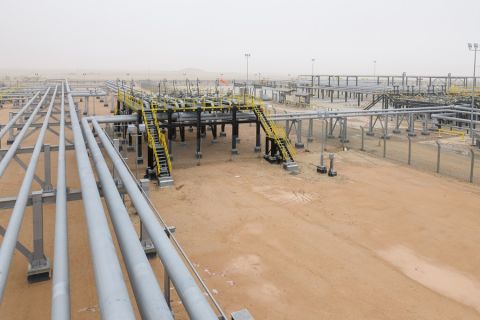NEW YORK—Energy Transfer LP (NYSE: ET) said on Feb. 21 it boosted capacity on the Dakota Access pipeline system to 570,000 barrels per day (bbl/d) as production in the Bakken shale basin has climbed to record highs.
Flows on the pipeline averaged above 500,000 bbl/d in the fourth quarter and nominations for space on the line exceeded available capacity during the quarter, a company executive said on its earnings call.
Energy Transfer said it is considering more expansions on the system due to the surge in demand, adding it would be able to add capacity by increasing horsepower to boost throughput.
In North Dakota’s Bakken region, shale production is estimated to rise about 13,000 bbl/d to a record 1.45 million bbl/d in March.
A shale revolution has helped propel the United States to the position of world’s biggest crude oil producer, ahead of Saudi Arabia and Russia. Total crude production has climbed to a weekly record of 11.9 million bbl/d.
Energy Transfer also said it has enough commitments to move forward on a proposed a 600-mile pipeline from the Permian Basin, the biggest oil patch in the country, to the Gulf Coast that would add at least 1 million bbl/d of capacity.
However, the company said it is now in talks with Exxon Mobil Corp. (NYSE: XON) and Plains All American Pipeline LP (NYSE: PAA) to possibly combine the two projects.
Exxon, Plains and Lotus Midstream said last month they will build a pipeline that can carry over 1 million bbl/d of oil and condensates from the Permian. That line is expected to begin operations in first-half 2021.
Energy Transfer’s Permian-to-Gulf-Coast (PGC) pipeline was expected to be in service in mid-2020, but it is now more likely to startup in 2021, if a Final Investment Decision (FID) can be made in the next 30 days.
“We’re in serious discussions with Exxon and Plains, if it makes more sense to join their project and have fewer projects built that are full on day one, that is certainly a possible direction we’ll go,” a company executive said.
Flows on all three lines of the company’s existing Permian Express pipelines are running at full capacity.
Recommended Reading
Shipping Industry Urges UN to Protect Vessels After Iran Seizure
2024-04-19 - Merchant ships and seafarers are increasingly in peril at sea as attacks escalate in the Middle East.
Paisie: Crude Prices Rising Faster Than Expected
2024-04-19 - Supply cuts by OPEC+, tensions in Ukraine and Gaza drive the increases.
Report: Freeport LNG Hits Sixth Day of Dwindling Gas Consumption
2024-04-17 - With Freeport LNG operating at a fraction of its full capacity, natural gas futures have fallen following a short rally the week before.
Permian NatGas Hits 15-month Low as Negative Prices Linger
2024-04-16 - Prices at the Waha Hub in West Texas closed at negative $2.99/MMBtu on April 15, its lowest since December 2022.
BP Starts Oil Production at New Offshore Platform in Azerbaijan
2024-04-16 - Azeri Central East offshore platform is the seventh oil platform installed in the Azeri-Chirag-Gunashli field in the Caspian Sea.


